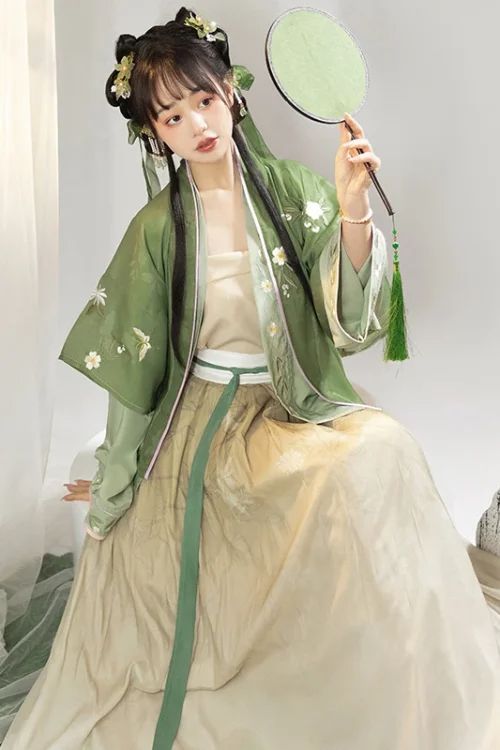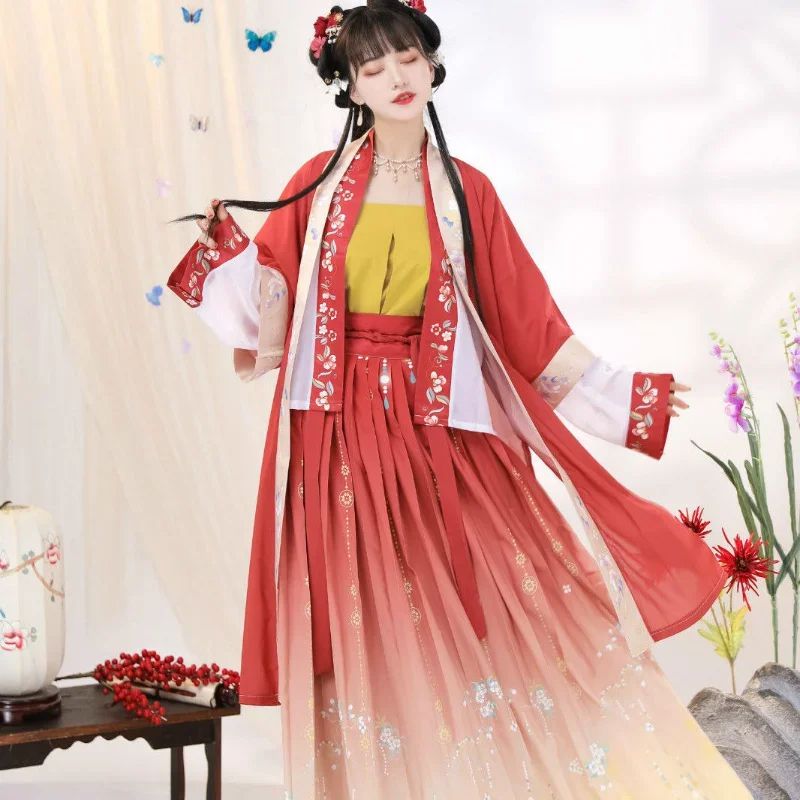The Evolution of 汉服 Silhouettes in the Song Dynasty
During the Song Dynasty, Hanfu, the traditional Chinese attire, underwent significant aesthetic transformations, resulting in a distinct silhouette that captivated the era. The Song Dynasty witnessed a shift towards a more refined and elegant aesthetic, which was reflected in the design and construction of Hanfu.

Emphasis on Layering
One of the most striking features of Song Dynasty Hanfu was the emphasis on layering. Garments were worn in multiple layers, creating a visually complex and sophisticated look. The undergarments, known as “zhongyi,” were typically made of silk or cotton and featured simple, flowing lines. Over these, a “beizi” or “shan” was worn, which was a long, loose robe that reached the ankles. The beizi was often made of a heavier fabric, such as brocade or damask, and was frequently decorated with intricate embroidery or patterns.
Wide, Flowing Sleeves
Another defining characteristic of Song Dynasty Hanfu was the use of wide, flowing sleeves. The sleeves of both the zhongyi and the beizi were often extremely wide, creating a graceful and ethereal effect. The sleeves were often gathered at the wrists, creating a bell-shaped silhouette. This emphasis on wide sleeves was a departure from the narrower sleeves of earlier Hanfu styles and reflected the Song Dynasty’s appreciation for elegance and movement.
Distinctive Neckline
In addition to the layering and wide sleeves, Song Dynasty Hanfu also featured a distinctive neckline. The neckline was typically high and rounded, with a narrow opening at the front. This neckline, known as the “yuanlingpao,” was designed to accentuate the wearer’s neck and shoulders, creating a delicate and feminine look.
Subtle Color Palette
The colors used in Song Dynasty Hanfu were also significant. While earlier Hanfu styles often featured bright and vibrant colors, the Song Dynasty saw a shift towards more muted and subtle hues. Earth tones, such as brown, green, and blue, were popular, as were pastel shades of pink, yellow, and lavender. These colors complemented the refined and elegant aesthetic of the era and created a harmonious and sophisticated look.
结论
Overall, the aesthetic features of Hanfu in the Song Dynasty reflected the cultural and artistic sensibilities of the time. The emphasis on layering, wide sleeves, a high neckline, and muted colors created a distinct and captivating silhouette that embodied the elegance and refinement of the Song Dynasty.
The Intricate Embroidery and Patterns of Song Dynasty Hanfu
During the Song Dynasty, Hanfu, the traditional Chinese attire, reached unprecedented heights of aesthetic refinement. Its intricate embroidery and patterns played a pivotal role in shaping its captivating beauty.

Exquisite Craftsmanship
The embroidery of Song Dynasty Hanfu was characterized by its exquisite craftsmanship and meticulous attention to detail. Skilled artisans employed a wide range of stitches, including satin stitch, chain stitch, and couching, to create intricate designs that adorned the garments. These designs often depicted auspicious symbols, such as dragons, phoenixes, and flowers, which were believed to bring good fortune and prosperity.
Elaborate Patterns
The patterns on Song Dynasty Hanfu were equally elaborate and varied. Geometric motifs, such as hexagons, octagons, and squares, were commonly used to create a sense of order and symmetry. Floral patterns, inspired by the natural world, added a touch of elegance and femininity to the garments. The use of contrasting colors and textures further enhanced the visual appeal of these patterns.
Kesi Weaving Technique
One of the most distinctive features of Song Dynasty Hanfu was the use of kesi, a type of tapestry weaving technique. Kesi involved weaving silk threads of different colors to create intricate patterns and images. This technique allowed for a high level of detail and precision, resulting in garments that were both visually stunning and technically impressive.
Symbolic Significance
The embroidery and patterns of Song Dynasty Hanfu were not merely decorative elements; they also served a symbolic purpose. The choice of motifs and colors was often influenced by the wearer’s social status, occupation, and personal beliefs. For example, dragons were reserved for the emperor and his family, while phoenixes were associated with high-ranking officials.
Lasting Impact
The aesthetic features of Song Dynasty Hanfu have had a lasting impact on Chinese culture and fashion. The intricate embroidery and patterns continue to inspire contemporary designers and artists, who incorporate elements of this traditional art form into their own creations. Moreover, the study of Song Dynasty Hanfu provides valuable insights into the cultural and artistic values of this pivotal period in Chinese history.
The Use of Color and Texture in Song Dynasty Hanfu
In the Song Dynasty, Hanfu, the traditional Chinese attire, reached its zenith of aesthetic refinement. The use of color and texture played a pivotal role in shaping the distinctive visual appeal of Song Dynasty Hanfu.

Conveying Social Status
Color played a significant role in conveying social status and personal preferences. Bright and vibrant hues, such as red, yellow, and green, were reserved for the elite, while more subdued colors, such as blue, gray, and white, were worn by commoners. The combination of contrasting colors, known as “duise,” was particularly popular, creating a harmonious and visually striking effect.
Texture and Fabric Choices
Texture also contributed to the aesthetic appeal of Hanfu. Silk, a luxurious and lustrous fabric, was the preferred choice for formal occasions. Its smooth and supple texture exuded elegance and sophistication. Cotton and linen, on the other hand, were more commonly used for everyday wear. These fabrics provided comfort and breathability, while their natural textures added a touch of rustic charm.
Enhancing Visual Appeal with Embroidery
The use of embroidery further enhanced the visual appeal of Hanfu. Intricate designs, often depicting flowers, birds, and auspicious symbols, were meticulously stitched onto the fabric. Embroidery not only added a decorative element but also conveyed personal style and cultural significance.
Overall Silhouette
In addition to color and texture, the overall silhouette of Hanfu also played a role in its aesthetic appeal. During the Song Dynasty, Hanfu for women featured a long, flowing skirt and a fitted bodice. The skirt was often pleated or gathered, creating a graceful and feminine silhouette. Men’s Hanfu, on the other hand, consisted of a long robe and trousers. The robe was typically belted at the waist, accentuating the wearer’s figure.
结论
The aesthetic features of Hanfu in the Song Dynasty were not merely decorative but also reflected the cultural values and social norms of the time. The use of bright colors and luxurious fabrics symbolized wealth and status, while the intricate embroidery showcased the skill and artistry of the artisans. The overall silhouette of Hanfu emphasized grace and elegance, embodying the refined and sophisticated culture of the Song Dynasty.
